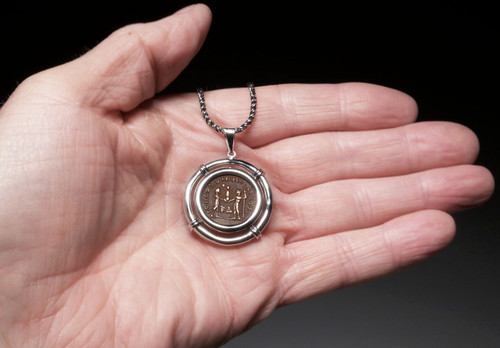Product Description
This authentic Roman bronze coin was minted during the rule of emperor "Constantine the Great" (Rome's first Christian emperor). This coin was minted before his Christian Conversion when he worshipped the Roman sun god, Sol. It is set with the reverse side showing a wonderful image of the Roman god SOL INVICTUS holding a globe with hand raised, and wearing a radiant crown. The display side coin reverse inscription reads, "SOLI INVICTO COMITI", meaning "Dedicated to his (the emperor's) Companion, the Unconquered Sol". The back side of the pendant shows the obverse of the coin, a side profile of the emperor Constantinus Maximus, "Constantine the Great".
A copper red-brown patina is highlighted by the mint green encrustations. The art beautifully contrasts with the bright polished sterling silver setting. It is set in hand-made sterling silver beaded tab back pendant.
Sol is the personification of the Sun and a god in ancient Roman religion. The Emperor Aurelian reintroduced the sun god and cult in 274 AD. The birthday of the Unconquered Sun was celebrated at the Roman festival Dies Natalis Solis Invicti on December 25. There is an ongoing debate regarding this date. Did it predate Christmas, or was it was later chosen to be the same day? We do know that Sol Invictus was worshipped in Rome until Christianity took hold as the dominant religion during the reign of Constantine the Great.
This genuine ancient Roman coin pendant would make an excellent and memorable gift for any "sun lover" or one who appreciates ancient history as well as one of Roman (Italian) descent.
*** Chain is not included but may be purchased additionally, at the link below
GUARANTEE: ALL PURCHASES ACCOMPANIED WITH A WRITTEN GUARANTEE OF AUTHENTICITY
SETTING: 925 STERLING SILVER
COIN: AE3
COIN AGE: 309 - 310 A.D.
DIMENSIONS: .85" diameter overall
:::: Includes Gift Box
:::: Includes CERTIFICATE OF AUTHENTICITY / HISTORY SHEET
ADD THE DISPLAYED STERLING SILVER ROUNDED BOX CHAIN NECKLACE
MORE ANCIENT ROMAN COIN JEWELRY
HISTORY
 No event in the history of the Western world was probably more pivotal than that of the Christian conversion of the emperor Constantine. Constantine the Great, as he is famously known, was the first ruler of the Roman Empire to convert to Christianity. His conversion resulted from a miraculous event that took place on the battlefield. Constantine was encamped with his army at the Milvian Bridge, heavily outnumbered by the armies of his challenger Maxentius, across the river. The following historical account was recorded at that time by an ancient writer as follows:
No event in the history of the Western world was probably more pivotal than that of the Christian conversion of the emperor Constantine. Constantine the Great, as he is famously known, was the first ruler of the Roman Empire to convert to Christianity. His conversion resulted from a miraculous event that took place on the battlefield. Constantine was encamped with his army at the Milvian Bridge, heavily outnumbered by the armies of his challenger Maxentius, across the river. The following historical account was recorded at that time by an ancient writer as follows:
"Constantine was praying to his father's god, beseeching him to tell him who he was and imploring him to stretch out his right hand to help him in his present difficulties. While he was fervently praying, an incredible sign appeared to him from heaven. It would be hard to believe his account if it had been told by anyone else. But the victorious emperor long afterwards declared it to the writer of this history -- when I was honored to meet and talk with him and he even confirmed his statement by an oath. Thus, who could doubt him, especially since time has established its truth? He said that about noon, when the day was already beginning to decline, he saw with his own eyes the trophy of a cross of light in the heavens, above the sun, and an inscription that said 'Conquer by This' attached to it. Seeing this, he and his army, which followed him on an expedition and witnessed the miracle, were struck with amazement. He said that he doubted within himself what importance the vision might hold. He continued to ponder its meaning through until he fell asleep. While sleeping, the Christ of God appeared to him with the same sign he had seen earlier in the heavens. God commanded him to make a likeness of that sign which he had seen in the heavens and to use it as a safeguard in all encounters with his enemies."
Immediately, Constantine placed the sign of Christ on his standards and had it painted on his shields. Constantine won the day with a decisive victory and Maxentius, thrown from the Milvian Bridge, was drowned when the weight of his armor caused him to sink into the mud and ooze at the bottom of the River Tiber. His body was recovered the day after the battle. From this point on, Christianity became the official religion of the Empire and the capitol was moved from Rome to Constantinople (modern day Istanbul, Turkey).
Upon the death of Constantine the Great in 337 A.D., the Empire was divided among his three sons. The eldest son, Constantine II, took most of the Western Europe, the second son, Constantius II, received the entire Eastern Empire and the youngest Constans, ruled Italy and North Africa under the regency of Constantine II.
 US Dollars
US Dollars
 AUD
AUD
 CAD
CAD
 POUNDS STERLING
POUNDS STERLING










